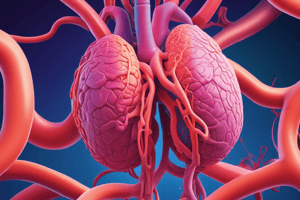Podcast
Questions and Answers
What is the main advantage of the separation between the right and left sides of the heart in mammals and birds?
What is the main advantage of the separation between the right and left sides of the heart in mammals and birds?
- It facilitates mixing of blood for temperature regulation.
- It allows for slower blood flow.
- It enhances the oxygenation process in the gills.
- It enables efficient oxygen supply to meet high energy needs. (correct)
Which statement is true about the heart structure of fish compared to that of mammals?
Which statement is true about the heart structure of fish compared to that of mammals?
- Mammals use a single circulation process like fish.
- Fish have a four-chambered heart.
- Mammals have a three-chambered heart like amphibians.
- Fish have a two-chambered heart and blood only passes through the heart once. (correct)
In animals like amphibians, what type of heart do they have and how does it affect blood mixing?
In animals like amphibians, what type of heart do they have and how does it affect blood mixing?
- They possess a two-chambered heart and efficiently utilize oxygen.
- They have no heart, letting diffusion supply oxygen.
- They have a four-chambered heart that prevents mixing.
- They have a three-chambered heart and tolerate some mixing of blood. (correct)
What characterizes the circulation process in mammals and birds compared to fish?
What characterizes the circulation process in mammals and birds compared to fish?
How do the energy needs of an organism affect its heart structure?
How do the energy needs of an organism affect its heart structure?
Flashcards are hidden until you start studying
Study Notes
Oxygen Transport and Heart Structure
- Oxygen enters the bloodstream in the lungs, enabling efficient gas exchange.
- The heart has a right and left side that separates oxygenated blood from deoxygenated blood.
- This separation enhances the efficiency of oxygen supply, critical for high-energy animals like birds and mammals.
Energy Utilization in Animals
- Mammals and birds maintain a constant body temperature, requiring a steady oxygen supply for energy.
- Animals like amphibians and many reptiles have variable body temperatures reliant on their environment, leading to different heart structures.
Heart Structures in Different Animals
- Amphibians and many reptiles possess three-chambered hearts that allow some mixing of oxygenated and deoxygenated blood.
- Fish have two-chambered hearts, where blood is pumped to the gills for oxygenation before reaching the body.
- In fish, blood circulates through the heart only once per cycle, unlike other vertebrates.
Circulation Types
- Double circulation refers to the system in vertebrates where blood passes through the heart twice during one full cycle of circulation.
Studying That Suits You
Use AI to generate personalized quizzes and flashcards to suit your learning preferences.




